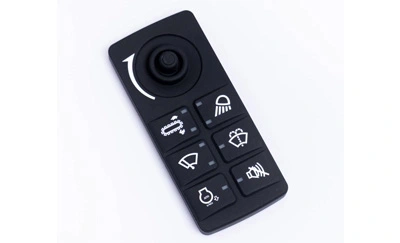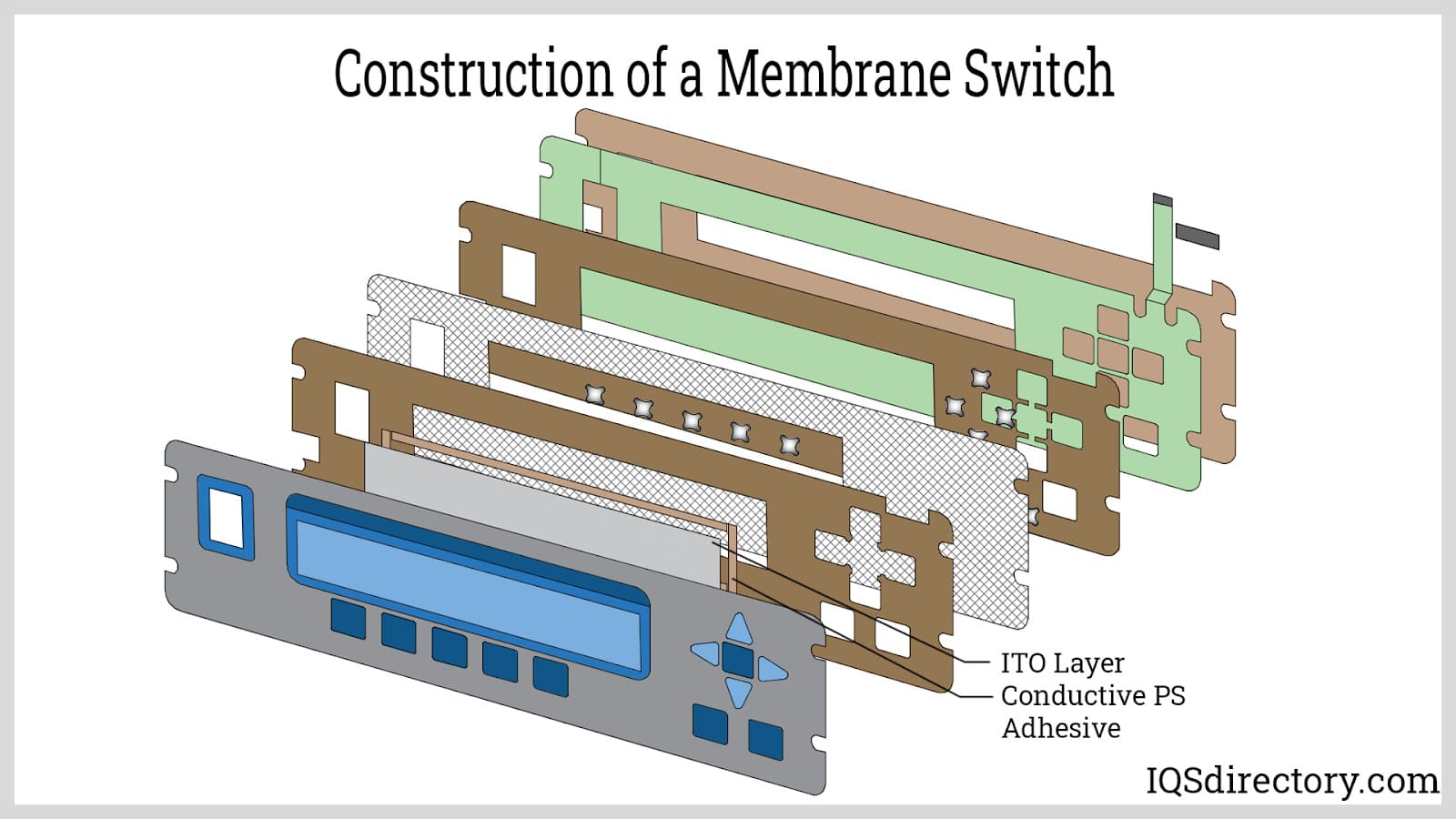Everything About Membrane Switch Over: A Comprehensive Guide for Beginners
Membrane layer switches are crucial parts in contemporary electronics, using a special interface for individual interaction - membrane switch. Their split construction, including overlays and conductive traces, provides capability and sturdiness. Unlike traditional mechanical buttons, membrane buttons provide a sleek style and adjustable options. Comprehending their crucial features and advantages can transform product design. Nevertheless, the ins and outs of their application and design considerations warrant additional expedition
What Is a Membrane layer Switch?
A membrane layer switch is a sort of electrical button that is composed of a flexible membrane layered over a printed motherboard. This design allows for a streamlined and compact interface, often used in numerous digital devices. Membrane layer switches are frequently located in customer appliances, clinical equipment, and industrial machinery because of their resilience and resistance to ecological factors.The construction usually consists of numerous layers, such as graphic overlays and glue support, which give responsive feedback and secure the wiring underneath. The operation of a membrane switch is launched when stress is put on the surface area, finishing an electric circuit.These switches are valued for their convenience, enabling custom styles and printed graphics that accommodate certain individual interfaces. Their low-profile nature decreases area needs, making them optimal for applications where traditional buttons might not fit. On the whole, membrane switches supply a aesthetic and functional service for modern digital devices.
Secret Components of Membrane Switches Over
Membrane layer changes consist of numerous essential parts that add to their performance and performance. The leading layer, called the overlay, provides the individual interface and is typically printed with signs or graphics. Below the overlay lies a spacer layer, which separates the conductive aspects and prevents unintentional activation. The following crucial element is the visuals layer, which boosts aesthetics and assures the toughness of the design.Conductive traces, normally made from materials like silver or carbon, are printed on the circuit layer. When pressure is related to the overlay, these traces enter call, finishing the circuit. In addition, a backing layer supplies structural assistance and can be made from products such as polyester or polycarbonate. Together, these parts produce a reliable, straightforward user interface suitable for numerous applications, from home devices to industrial equipment. Comprehending these elements is necessary for anybody curious about membrane button technology.
How Membrane Layer Switches Work
Recognizing how membrane switches over function is necessary for appreciating their prevalent use in numerous tools. A membrane switch operates with a collection of layers, consisting of a graphic overlay, spacer, and a circuit layer. When pressure is related to the overlay, it presses the spacer layer, permitting the circuit layer to make contact and complete an electrical circuit. This activity sends a signal to the device, triggering a reaction, such as activating a light or activating a function.Membrane switches can be developed with different functions, consisting of responsive feedback, backlighting, and custom graphics, boosting user interaction. Their building and construction permits a sealed layout, protecting the inner parts from dirt, dampness, and pollutants. This resilience makes them appropriate for diverse applications, from consumer electronic devices to commercial tools. Overall, the simpleness and performance of membrane switches contribute to their appeal in modern-day innovation.
Advantages of Membrane Switches Mechanical Buttons
While mechanical switches have actually long been a staple in lots of gadgets, membrane layer changes offer distinctive advantages that make them increasingly appealing. One considerable benefit is their slim profile, permitting even more small layouts and higher versatility in product development. Additionally, membrane switches over attribute an uniform surface, which improves aesthetic allure and streamlines cleaning, making them suitable for settings where hygiene is critical.Another benefit is their resistance to dust and moisture. Unlike mechanical switches, which can be jeopardized by ecological factors, membrane switches provide a closed interface that protects versus contaminants - membrane switch. Membrane switches normally have a longer life expectancy due to less relocating components, resulting in enhanced sturdiness and reliability.Cost-effectiveness is additionally a remarkable benefit, as membrane switches can be produced in bulk with lower manufacturing prices. These variables incorporate to position membrane layer buttons as a functional choice to typical mechanical options in different applications
Usual Applications of Membrane Switches
Membrane buttons are widely utilized in numerous industries, particularly in customer electronic devices and commercial control board. In customer devices, they supply a smooth, straightforward user interface, while in commercial settings, they boost longevity and performance. Recognizing these applications highlights the convenience and functionality of membrane layer buttons in modern-day technology.
Consumer Electronic Devices Devices
As consumer electronics remain to progress, membrane layer buttons have actually come to be a popular selection for a selection of devices due to their convenience and streamlined layout. These buttons are generally found in mobile phones, tablet computers, and push-button controls, where area is restricted and appearances issue. Their reduced account and personalized layouts permit makers to produce easy to use interfaces that enhance the general individual experience. In addition, membrane layer switches are usually made use of in devices such as microwaves and coffee manufacturers, supplying intuitive control options while resisting dampness and dust. The toughness and reliability of membrane switches make them ideal for daily consumer products, guaranteeing durability and constant performance. Generally, their combination in consumer electronic devices shows a mix of functionality and modern layout.
Industrial Control Panels
The applications of membrane layer switches prolong beyond consumer electronic devices, finding substantial use in industrial control board. These switches are preferred for their durability and resistance to rough atmospheres, making them optimal for manufacturing and procedure control settings. They provide a trusted interface for more information drivers to manage equipment, screen procedures, and adjust setups. Membrane layer buttons can be customized to fit specific functional requirements, incorporating functions like backlighting and responsive comments, improving user experience. Their inconspicuous layout enables for integration right published here into various devices, while their capacity to endure spills, dirt, and extreme temperature levels guarantees durability. On the whole, membrane buttons add to effective and secure operation in industrial applications, showing their convenience and effectiveness popular environments.
Considerations for Creating Membrane Layer Switches Over
When developing membrane layer switches, selecting the best products is necessary to ensure longevity and functionality. Additionally, comprehending layer arrangement methods can considerably influence the button's efficiency and user experience. These considerations play a crucial function in producing dependable and efficient membrane switch designs.
Material Choice Significance
Material selection plays a necessary duty in the style and performance of membrane layer buttons. The picked products straight impact the switch's sturdiness, tactile reaction, and general aesthetic. Key factors to consider include the substrate, which need to provide architectural stability while enabling adaptability, and the visuals overlay, which needs to be immune to use and environmental elements. Conductive materials need to assure dependable electrical performance, while adhesives have to use strong bonding without jeopardizing the switch's procedure. Furthermore, compatibility with manufacturing processes and end-user settings is important; materials have to stand up to varying temperatures, moisture levels, and chemical exposure. Eventually, suitable material selection not just enhances the membrane layer button's performance yet likewise contributes to its long life and customer contentment, making it a vital aspect of the layout process.

Layer Configuration Strategies

Frequently Asked Inquiries
For How Long Do Membrane Changes Usually Last?
Membrane buttons generally have a life expectancy of 1 to 5 million cycles, depending on usage and environmental problems. Factors such as style quality and operating frequency substantially influence their resilience and overall efficiency long life.

Can Membrane Switches Be Custom-made for Particular Styles?
Membrane buttons can without a doubt be tailored to fit details layouts, enabling for diverse forms, shades, and functionalities. This flexibility allows producers to tailor these buttons to meet unique aesthetic and functional demands properly.
What Products Are Used in Membrane Change Construction?
Membrane layer buttons are normally constructed utilizing materials such as polyester, polycarbonate, and sticky layers. These products give resistance, adaptability, and resilience to ecological factors, guaranteeing the buttons operate efficiently in different applications and problems.
Are Membrane Layer Changes Immune or waterproof to Moisture?
Membrane buttons can be made to be moisture-resistant, making use of specialized products and layers. Their water resistant abilities depend on building top quality and specific applications, making it important to evaluate demands for optimal performance in numerous settings.
Just How Are Membrane Layer Changes Repaired if Damaged?
Repairing broken membrane switches generally involves changing the affected layer or circuit. Specialists may also use conductive sticky or utilize specialized repair service packages, making sure performance is brought back without complete substitute of the entire button setting up. Unlike standard mechanical switches, membrane buttons provide a smooth design and personalized choices. A membrane button is a kind of electric switch that is composed of an adaptable membrane layered over a published circuit board. The procedure of a membrane layer switch is launched when stress is applied to the surface area, finishing an electrical circuit.These switches are valued for their adaptability, enabling custom-made styles and printed graphics that provide to particular customer interfaces. While mechanical switches have long been a staple in numerous tools, membrane switches over offer distinctive benefits that make them significantly appealing. Membrane buttons generally have a longer life-span due to fewer relocating components, resulting in boosted sturdiness and reliability.Cost-effectiveness is also a significant benefit, as membrane buttons can be produced in bulk with lower production costs.